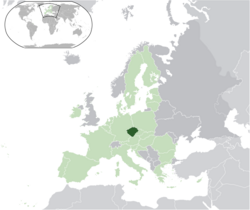
Back Boheme Afrikaans Böhmen ALS Bohemia AN Bæmaland ANG بوهيميا Arabic Bohemia AST Bohemiya Azerbaijani Behmen BAR Багемія Byelorussian Багемія BE-X-OLD
Bohemia
| |
|---|---|
| |
 Bohemia (green) overlapped with the current regions of the Czech Republic | |
 Location of Bohemia in the European Union | |
| Country | Czech Republic |
| Capital | Prague |
| Area | |
• Total | 52,065 km2 (20,102 sq mi) |
| Population (2024)[1] | |
• Total | 6,880,000 |
| • Density | 130/km2 (340/sq mi) |
| Demonym | Bohemian |
| Time zone | UTC+1 (CET) |
| • Summer (DST) | UTC+2 (CEST) |
Bohemia (/boʊˈhiːmiə/ boh-HEE-mee-ə;[2] Czech: Čechy [ˈtʃɛxɪ] ⓘ;[3] German: Böhmen [ˈbøːmən] ⓘ; Upper Sorbian: Čěska [ˈtʃɪska]; Silesian: Czechy) is the westernmost and largest historical region of the Czech Republic. Bohemia can also refer to a wider area consisting of the historical Lands of the Bohemian Crown ruled by the Bohemian kings, including Moravia and Czech Silesia,[4] in which case the smaller region is referred to as Bohemia proper as a means of distinction.[5]
Bohemia was a duchy of Great Moravia, later an independent principality, a kingdom in the Holy Roman Empire, and subsequently a part of the Habsburg monarchy and the Austrian Empire.[6] After World War I and the establishment of an independent Czechoslovak state, the whole of Bohemia became a part of Czechoslovakia, defying claims of the German-speaking inhabitants that regions with German-speaking majority should be included in the Republic of German-Austria. Between 1938 and 1945, these border regions were annexed to Nazi Germany as the Sudetenland.[7]
The remainder of Czech territory became the Second Czechoslovak Republic and was subsequently occupied as the Protectorate of Bohemia and Moravia until the end of World War II, after which Bohemia became part of the restored Czechoslovakia. In 1969, the Czech lands (including Bohemia) were given autonomy within Czechoslovakia as the Czech Socialist Republic. In 1990, the name was changed to the Czech Republic, which became a separate state in 1993 with the breakup of Czechoslovakia.[7]
Until 1948, Bohemia was an administrative unit of Czechoslovakia as one of its "lands" (země).[8] Since then, administrative reforms have replaced self-governing lands with a modified system of "regions" (kraje), which do not follow the borders of the historical Czech lands (or the regions from the 1960 and 2000 reforms).[8] However, the three lands are mentioned in the preamble of the Constitution of the Czech Republic: "We, citizens of the Czech Republic in Bohemia, Moravia and Silesia..."[9]
| Year | Pop. | ±% |
|---|---|---|
| 1869 | 5,119,968 | — |
| 1880 | 5,575,812 | +8.9% |
| 1890 | 5,858,677 | +5.1% |
| 1900 | 6,335,301 | +8.1% |
| 1910 | 6,787,632 | +7.1% |
| 1921 | 6,675,404 | −1.7% |
| 1930 | 7,114,712 | +6.6% |
| 1950 | 5,677,200 | −20.2% |
| 1961 | 5,991,967 | +5.5% |
| 1970 | 6,028,088 | +0.6% |
| 1980 | 6,270,672 | +4.0% |
| 1991 | 6,245,688 | −0.4% |
| 2001 | 6,202,210 | −0.7% |
| 2011 | 6,479,056 | +4.5% |
| 2021 | 6,609,326 | +2.0% |
| Source: Censuses[10][11] | ||
Bohemia had an area of 52,065 km2 (20,102 sq mi), and today is home to about 6.9 million of the Czech Republic's 10.9 million inhabitants. Bohemia was bordered in the south by Upper and Lower Austria (both in Austria), in the west by Bavaria (in Germany), and in the north by Saxony and Lusatia (in Germany and Poland, respectively), in the northeast by Silesia (in Poland), and in the east by Moravia (also part of the Czech Republic). Bohemia's borders were mostly marked by mountain ranges such as the Bohemian Forest, the Ore Mountains, and the Giant Mountains; the Bohemian-Moravian border roughly follows the Elbe-Danube watershed.
- ^ "Population of Municipalities – 1 January 2024". Czech Statistical Office. 17 May 2024.
- ^ "Bohemia" Archived 23 November 2018 at the Wayback Machine. Random House Webster's Unabridged Dictionary.
- ^ There is no distinction in Czech between adjectives referring to Bohemia and to the Czech Republic; i.e. český means both Bohemian and Czech.
- ^ The Columbia Encyclopedia, Sixth Edition. 2001–05
- ^ The Cambridge Modern History. The Macmillan Company. 1902. p. 331. Archived from the original on 3 October 2023. Retrieved 17 March 2021.
- ^ Jiří Pehe: Co vlastně slavíme 28. října? Archived 12 November 2017 at the Wayback Machine
- ^ a b "Bohemia". Archived from the original on 20 June 2012. Retrieved 2 June 2012.
- ^ a b Petr Jeřábek: Krajské uspořádání? Vadí i po čtrnácti letech Archived 27 September 2016 at the Wayback Machine, Deník.cz, 2 January 2014, compare maps and texts Archived 27 January 2018 at the Wayback Machine
- ^ Ústava České republiky Archived 26 January 2018 at the Wayback Machine, 1/1993 Sb. (Constitution of the Czech Republic)
- ^ "Historický lexikon obcí České republiky 1869–2011" (in Czech). Czech Statistical Office. 21 December 2015.
- ^ "Results of the 2021 Census - Open data". Public Database (in Czech). Czech Statistical Office. 27 March 2021.





